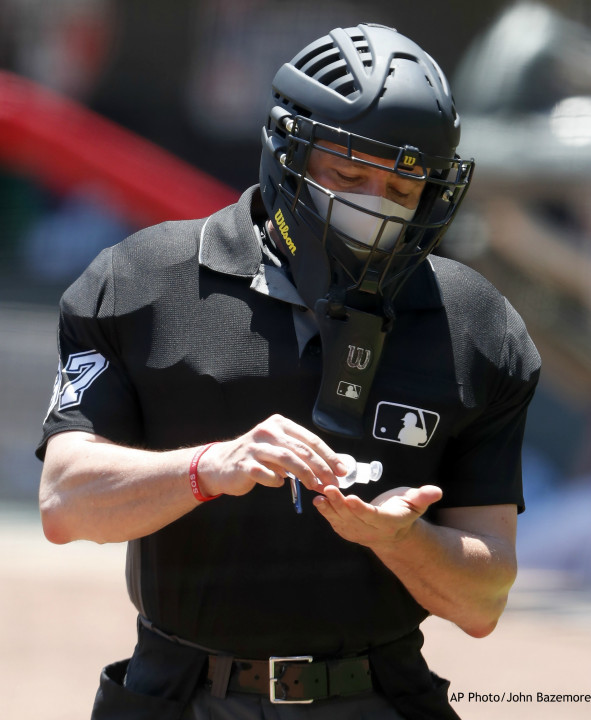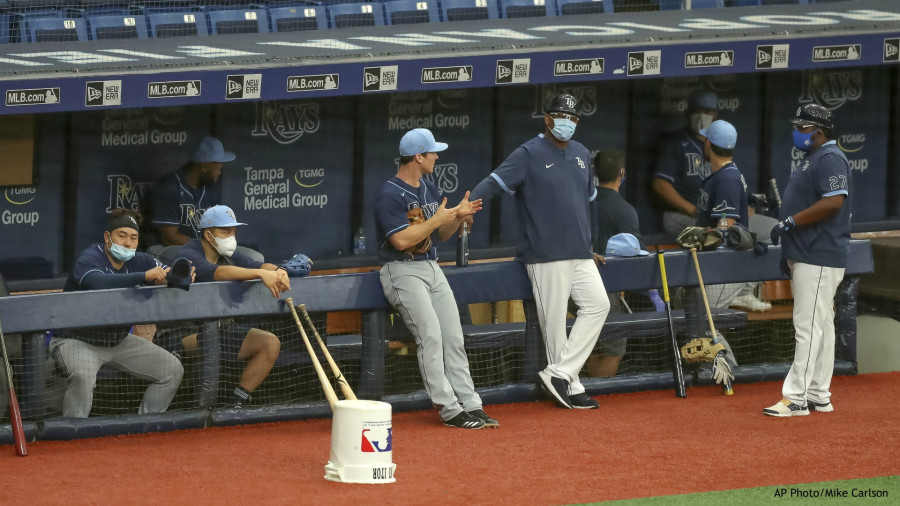NEW YORK (AP) — Thirty baseball teams from 28 cities, trying to play 60 games each amid a coronavirus pandemic that seemingly hasn’t peaked in the United States. Plausible? Worthwhile? Unconscionable?
Even among experts, it depends on who’s talking:
“Baseball games can work,” said Dr. David Hamer, professor of global health at the Boston University School of Public Health. “I think it’s feasible.”
“There are certain sports that are higher risk versus lower risk,” said Dr. Amesh Adalja, senior scholar at the Johns Hopkins Center for Health Security. “Baseball is sort of an intermediate risk.”
“I’m very nervous about MLB’s plan,” said Dr. Zach Binney, an epidemiologist at Emory University. “It could be a disaster.”

Public health experts have mixed feelings about baseball’s hopes to open its season July 23. There is optimism because of the nature of the sport itself, which produces less on-field risk than basketball, football or hockey. Then again, players and their families face a daunting task staying safe away from the ballpark, especially with teams traveling to and from hard-hit regions, including Florida and Texas.
Unlike the NBA and NHL, Major League Baseball teams won’t be sequestered into bubbles — they’ll be traveling all around the country.

Most of all, though, there’s uncertainty.
“I don’t think you can completely quantify exactly what the risk will be,” Adalja said.
MLB has provided teams with a 113-page operations manual detailing protocols for its pandemic-shortened 60-game regular season.
Players will be tested every 48 hours. Masks and social distancing are a must at all times, except on the field. Backups can watch games from the stands instead of the dugout. No sunflower seeds. No spitting. No licking fingers. Even the mascots won’t be allowed to get close.
There are protocols for air travel, bus travel, private cars and hotels, along with general guidance to avoid contact with people outside of the baseball world.
Can all of that keep players safe? Can it keep MLB from straining resources in their host communities? What if fans are allowed to attend games in September and October, as some team owners have suggested?
In short, can it work?
Two weeks into preseason camps, there’s some reason for optimism.
According to data released Friday by MLB, just 0.4% of samples from players and coaches tested since June 27 have come back positive. That’s far below the national positive rate of about 9%.
There have been delays in testing, most notably around the July 4 weekend, and all but two of the 30 teams have had at least one person test positive.
Still, the results are undoubtedly encouraging.
“That’s a good starting point,” said Hamer, an infectious disease specialist at Boston Medical Center who has advised other pro sports leagues.
It’s too soon to say if that can last.
Testing is a critical pillar of MLB’s plan, but it’s hardly foolproof. Set aside frustrating delays that forced several teams to cancel practice — even when screenings are handled perfectly, there are flaws.
Players and on-field personnel provide samples every 48 hours, and results are supposed to take one to two days to process. That means players can take a test, participate in one or two games or practices and not find out until after that they have COVID-19.
“There’s so many cases, you may not catch them fast enough,” Binney said.
So transmission risk has to be kept low, even with coronavirus-positive players in uniform.
The nature of the sport should help.
“It’s not fleeting contacts that spread this virus,” said Adalja, who is also on the NCAA’s COVID-19 advisory panel. “It’s close contact for 10 to 15 minutes, so something like people hanging out in the dugout is much more likely, epidemiologically, to lead to the spread of the virus.”

The field of play — even the batter’s box — should be fairly safe, except perhaps for the catcher and plate umpire. Adalja also said the baseball itself shouldn’t be an issue, since surface-based transmission is less common.
“The risk of onward transmission to teammates is going to be very low,” Hamer said.
Adalja and Hamer are hopeful about MLB’s protocols, noting that exposure can be limited on socially distanced chartered flights, in hotels and at spacious ballparks without fans.
“The risk of aerosol transmission on a plane is pretty much limited to the row you’re in and maybe a row ahead and a row behind,” Hamer said.
“I do think that they do provide substantial benefit and decrease the risk of transmission,” Adalja said of baseball’s off-field protocols. “But it’s not going to be ironclad.”
Binney is more concerned. He thinks bubble systems like those used by the NBA and NHL are a worthwhile gamble, but he’s worried that MLB’s protocols will be inadequate in virus-stricken areas like Florida and Texas.
“That can all stop a few cases, and maybe even a moderate number of cases,” he said of MLB’s plans. “But if you’re getting cases from the community left and right, I have some concerns about its ability to withstand that.”
Experts aren’t worried that traveling ballclubs might endanger communities in a significant way. The traveling parties will be relatively small, and because they’ll be using private transportation, there shouldn’t be much interaction with people not affiliated with the league in some manner.
In fact, the opposite is likely true — if the league fails, it may be because players can’t avoid the virus in the hours when they’re away from teammates.
“I’m more worried honestly about the exposures in the community,” Hamer said. “Going out for dinner or drinks or whatever after the game, and what kind of exposures they might have there that increase the risk of being infected rather than the other way around.”
MLB is also trying to ensure its roughly 10,000 weekly tests don’t strain public resources by using private facilities. Adalja said such a conflict might arise in some regions, but he also thought MLB’s investment might encourage much needed innovation and increased production in testing.
There’s one way MLB could pose a grave public risk, according to Binney — by opening its doors to fans.
Owners of the New York Yankees, Texas Rangers and Houston Astros have said they hope to host limited-capacity crowds by the end of the season. Binney called the idea “completely unreasonable” until a vaccine is developed.
“When you start talking about fans, you’re adding a whole lot of risk, particularly to the public’s health,” Binney said. “And the only benefit is money in the pocket of owners and stadium authorities.”
Adalja and Hamer think that socially distancing a stadium — bleachers, bathrooms, concession lines and elsewhere — was plausible but tricky.
Before any of that can be considered, though, the virus has to be curbed.
CORONAVIRUS RESOURCES

Introvert. Beer guru. Communicator. Travel fanatic. Web advocate. Certified alcohol geek. Tv buff. Subtly charming internet aficionado.